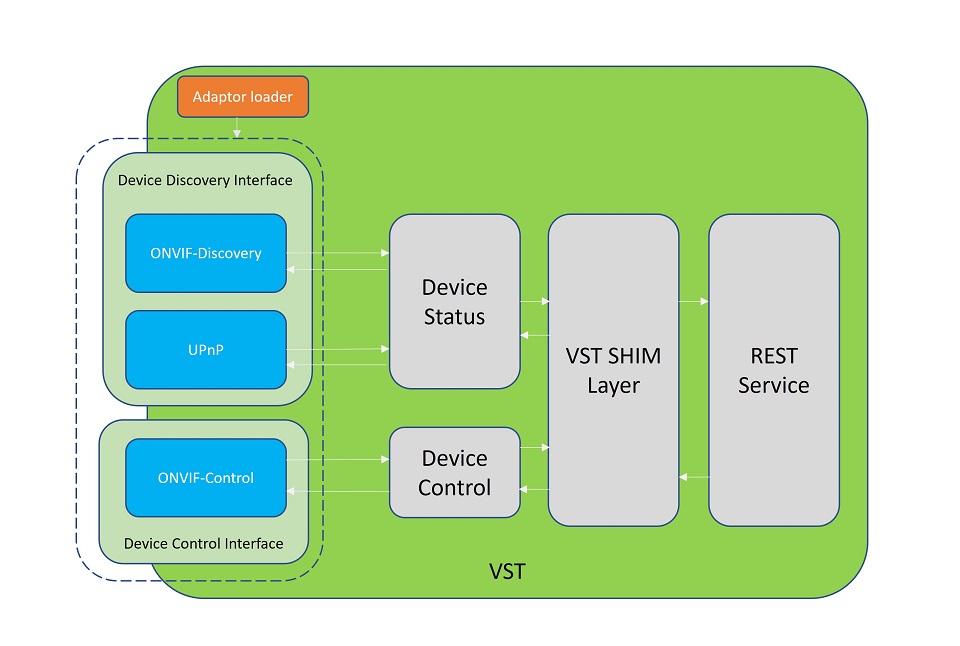Components & Customization
Adaptor Architecture

Adaptor architecture has 2 interfaces. Both the interfaces can be loaded using Adaptor loader.
1) Device Discovery Interface
This adaptor interface is used to discover devices, for example, ONVIF Protocol or UPnP Protocol:
A new Device Discovery Adaptor should implement
IDeviceDiscoveryInterfaceClass (refer to theinclude/device_discovery_adaptor.hheader file from VST container)Implement the following methods to create and destroy adaptor object:
typedef IDeviceDiscoveryInterface* createDiscoveryObject(); typedef void destroyDiscoveryObject ( IDeviceDiscoveryInterface* object );
2) Device Control Interface
This adaptor interface controls the devices, for example, ONVIF Control Protocol:
A new Device Control Adaptor should implement
IDeviceControlInterfaceClass (refer to theinclude/device_control_adaptor.hheader file from VST container)Implement the following methods to create and destroy adaptor object:
typedef IDeviceControlInterface* createObject(); typedef void destroyObject( IDeviceControlInterface* object );
Application Development
This section helps developers to get insights of VST APIs.
VST offers a set of REST APIs for client applications, providing the developers access to all the features of VST.
VST APIs are compliant to OpenAPI standards, so developers are able interact with VST via HTTP GET/POST request.
Get all device’s details:
GET *api/v1/sensor/list*Request type : GET
Sample request URL:
https://IP_ADDRESS:PORT_NUMBER/api/v1/sensor/list
Sample response on success, otherwise empty response:
[ { "firmwareVersion": "string", "hardware": "string", "hardwareId": "string", "sensorId": "string", "sensorIp": "string", "location": "string", "manufacturer": "string", "name": "string", "position": { "depth": "string", "direction": "string", "fieldOfView": "string", "coordinates": { "x": "string", "y": "string" }, "geoLocation": { "latitude": "string", "longitude": "string" }, "origin": { "latitude": "string", "longitude": "string" } }, "serialNumber": "string", "state": "online", "tags": "string" } ]
Get list of sensor streams information (RTSP URLs):
GET *api/v1/sensor/streams*Request type : GET
Sample request URL:
https://IP_ADDRESS:PORT_NUMBER/api/v1/sensor/streams
Sample response on success, otherwise NULL:
[ { "7927cbbc-cba6-4f22-b65d-46f7382f5f65": [ { "streamId": "7927cbbc-cba6-4f22-b65d-46f7382f5f65", "isMain": true, "url": "rtsp://10.41.18.147:8554/live/7927cbbc-cba6-4f22-b65d-46f7382f5f65", "name": "HIKVISION%20DS-2CD2T43G0-I5", "metadata": { "bitrate": "8000", "codec": "H264", "framerate": "30", "govlength": "60", "resolution": "1920x1080" } } ] } ]
Get device status:
GET *api/v1/sensor/status*Request type : GET
Sample request URL:
https://IP_ADDRESS:PORT_NUMBER/api/v1/sensor/status
Sample response on success, otherwise NULL:
{ "Amcrest" : { "error_code" : "NoError", "error_message" : "No Error", "name" : "Amcrest", "state" : "online" } }
Add new device (applicable for 1) Device Discovery Interface):
POST *api/v1/sensor/add*This API is used to add device using IP Address or using RTSP URL. Add device using IP Address : url field can be omitted. Add device using RTSP URL : sensorIp, username and password fields can be omitted.
Request type: POST
Request Body:
{ "sensorIp": "string", "name": "string", "location": "string", "hardware": "string", "username": "string", "password": "string", "manufacturer": "string", "serialNumber": "string", "firmwareVersion": "string", "hardwareId": "string", "tags": "string" }
Sample response on success, otherwise Error:
{ "sensorId": "string" }
Authenticate devices (applicable for 1) Device Discovery Interface) :
POST *api/v1/sensor/{sensor-id}/credentials*Request type : POST
sensor-id : Sensor ID retrieved using,
api/v1/sensor/listRequest Body:
{ "password": "string", "username": "string" }
Sample Response on success, otherwise Error:
true
Start Recording of device streams:
POST api/v1/record/{stream-id}/start
Request type : POST
sensor-id : Sensor ID retrieved using, api/v1/sensor/list
Request Body:
{ "streamId": "{stream-id}" }
Sample response on success, otherwise Error:
true
Stop Recording of device streams:
POST api/v1/record/{stream-id}/stop
Request type : POST
sensor-id : Sensor ID retrieved using, api/v1/sensor/list
Request Body:
{ "streamId": "{stream-id}" }
Sample response on success, otherwise Error:
true
Initiate scan for new devices in subnet applicable for 1) Device Discovery Interface:
POST api/v1/sensor/scan
Request type : GET
Sample Request:
https://IP_ADDRESS:PORT_NUMBER/api/v1/sensor/scan
Sample response on success, otherwise NULL:
true
Refer API section which provides details on all the supported RESTful APIs.
Error
Name |
Type |
Description |
Required |
|---|---|---|---|
error_code |
string |
_Example:_ “VSTInternalError” |
Yes |
error_message |
string |
_Example:_ “VST internal processing error” |
Yes |
VST Errors
HTTP Code |
Error Code |
Error Message |
|---|---|---|
0 |
NoError |
No Error |
403 |
DeviceUnauthorizedError |
Device is not authorized |
401 |
ClientUnauthorizedError |
Client is not authorized |
400 |
InvalidParameterError |
Invalid or out of range parameters |
404 |
DeviceNotFoundError |
Device not found OR device id is not valid |
405 |
MethodNotAllowedError |
Method Not Allowed |
408 |
DeviceRequestTimeoutError |
Request Timeout |
500 |
CommunicationError |
Device communication error |
500 |
VSTInternalError |
VST internal processing error |
501 |
VSTNotSupportedError |
Operation/Action not supported |
507 |
VSTInsufficientStorage |
Insufficient Storage |